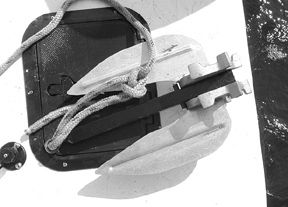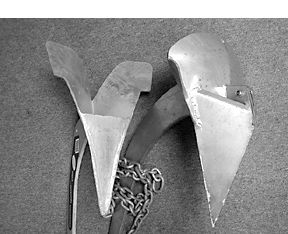
Practical Sailor has run a series of anchor tests in the past few years. In the February 1, 1998 issue we tested 11 models on a sandy beach, in both packed wet sand and under water. In that test the Bruce anchor was rated the best at setting, but it was noted that in several tests by other groups, the Bruce was relatively poor at ultimate holding power. Our own subsequent holding power tests have tended to confirm that, although we still think the Bruce is a good, versatile hook.
In the January 1, 1999 issue we ran the results of a holding power test of 15 anchors in sand. Two little-known anchors-the Spade Model 80 and the Bulwagga-proved especially tenacious, holding out to 1,000 lbs. and 880 lbs. respectively, as measured on a Dillon dynamometer.
Then we tested 17 anchors in mud and published the results in the December 1999 issue. The Barnacle anchor, which had ranked fair to middling in the sand, triumphed in the mud, holding to 800 lbs. The next-best mud contender was the venerable CQR, which held to 760 lbs.
Last year, in the January 15 issue, we produced results for an anchor reset test, in which we set 18 anchors in sand, pulled them to 200 lbs. of pressure, then veered the rode 140 to 150 degrees, pulled the rode taut, hauled away, and measured the distance it took for the hooks to reset. The best group in this test-those that reset with little or no breakout or movement-were the Bruce, the Fortress FX-16, the Supermax (with adjustable shank), and the Spade Model 80.
One of the anchors in the first two tests was the Digger, a fluke-type anchor with a releasing shank, made in Minnesota. It has several moving parts, including a body or hub with cleats or “diggers” that are intended, according to the literature, to “put constant downward pressure on flukes to set fast and keep digging down.” There are two bolted-on flukes, and a shank that contains the mechanism for releasing the flukes when the anchor rode is given a sharp jerk, either when “the anchor is pulled up vertically to the boat or if in a near horizontal position like when being released from rocks or logs.” The Digger is meant to be set at a scope of 5:1, and without any chain-a rope rode only.
In neither of those tests could we get the Digger to set properly, and it was not included in the two more recent tests.
Last spring we got a call from the Digger’s inventor, Dick Zetah, asking us to try the Digger again. He didn’t believe that our previous testing had been fair or realistic. He told us that over 100,000 of these anchors have been sold, through over 1,000 dealers, and that they meet with almost universally enthusiastic response. He sent us a new 15-lb. Digger ($89) intended to hold “boats, pontoons, and sailboats to 36 feet.” It came with quite a bit of promotional material, including some impressive testimonials.

In the early fall another anchor marched in the door, this one a 22-lb. QuickSet ($189) from Kingston Anchors in Ontario. It’s a plow-type anchor with no moving parts. According to company literature, its “patented lateral fins trip the anchor, resulting in the fastest setting anchor… Cylindrical flukes bury deeply for high holding power.”
Well, now we had the makings of a good Update article.
On a sunny, calm October day we took both anchors out in the Powerboat Reports test boat, a 22′ Twin-Vee with twin Suzuki 90-hp. four-strokes. We brought along a sturdy rope rode, chain for the QuickSet (not for the Digger), and our trusty Dillon dynamometer.
The Face-Off, Such As It Was
We tried the QuickSet first, with 6 feet of chain between anchor and rode. We anchored in 8-9 feet of water. The bottom was sandy mud (or muddy sand, if you prefer) with small bits of broken shell and pebbles. There were occasional clumps of mussels loose on the bottom, torn from distant rocks in a strong blow we’d had a few days before. We could actually see the bottom dimly-a rare occurrence in these parts.
We set up a rope bridle from the midships cleats to a point on the centerline just forward of the engines, then shackled the dynamometer to the bridle, and went to work.
The QuickSet dug in almost instantly. We let out a scope of 5:1, attached the rode to the Dillon, and slowly applied pressure from the twin Suzukis. The dynamometer climbed to 600 pounds, the anchor tripped and skidded for a few feet, then reset itself and shock-loaded the dynamometer up to 750 lbs. We built the pressure back up to a steady 780 lbs. for a few seconds without incident, then backed off for fear of pulling the cleats out of the boat.
We’ll look forward to comparing the QuickSet in the future to the many old acquaintances lurking metallically in the basement.
We then eliminated the chain and attached the rope rode directly to the welded swiveling eye at the top of the Digger’s shank. We lowered the Digger carefully over the stern in the correct attitude and watched it fly straight and level to the bottom. Then we idled the boat forward, rode in hand, trying a little pressure once in a while to see if we got a bite. None was forthcoming. When we had the 40′ rode marker exactly at the water’s surface we tried more hand pressure. No set. We belayed the rode on the Dillon and kept idling forward. We went quite a way. No set. So we pulled the anchor up and found that the flukes had tripped. OK-maybe we had too much catenary in the rode, and pulled a little too hard initially, and tripped it at the low angle.
We reset the flukes, lowered away, and tried again. No go.

It was October, but the water was still warm enough for swimming, so one of us went overboard with a mask, set the anchor firmly by hand, and stayed at the bottom watching as the boat driver idled forward again. The Digger popped out almost instantly, and although the flukes stayed locked correctly, they never dug in again. Time after time, at scopes varying from 4:1 to 7:1, the anchor skittered lightly over the bottom, digging in the tips of its flukes occasionally but never setting. We tried setting the anchor about 15 times (lost track) in the course of the next 45 minutes, without a bit of luck.
When we talked to Mr. Zetah on the phone and described the whole procedure, he said we must have done something wrong. We asked if he’d like to have the anchor back to see if it was faulty in some way. He said yes, and we sent it back.
It could be that we did something wrong, but we don’t know what that might have been. We set quite a few anchors around here, and have done so over many years and in many conditions. The Digger, apparently, is just not a device that sets well with us. And we’ll leave it at that.
Contacts- Digger Anchor Company, 40154 So. Hwy. 71, Sauk Centre, MN 56378, 320/352-6011, www.diggeranchor.com/. Kingston Anchors, Ltd., 143 Hickson Ave., Kingston, ON K7L 4R3, 613/549-2718.






































